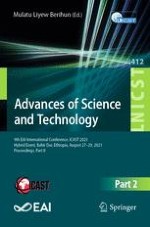2022 | Buch | 1. Auflage
Advances of Science and Technology
9th EAI International Conference, ICAST 2021, Hybrid Event, Bahir Dar, Ethiopia, August 27–29, 2021, Proceedings, Part II
herausgegeben von: Mulatu Liyew Berihun
Verlag: Springer International Publishing
Buchreihe : Lecture Notes of the Institute for Computer Sciences, Social Informatics and Telecommunications Engineering
